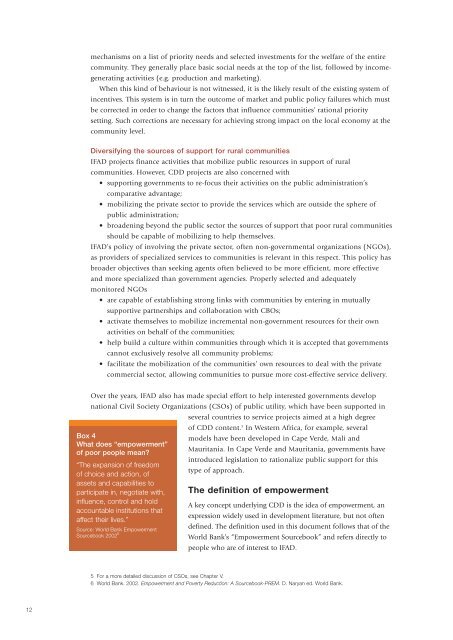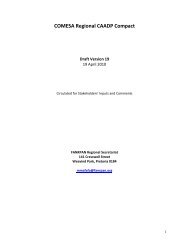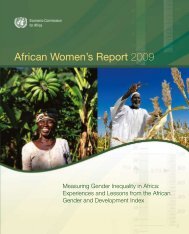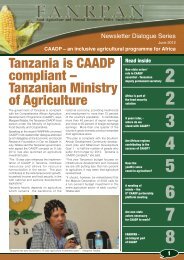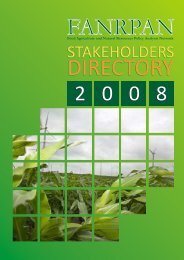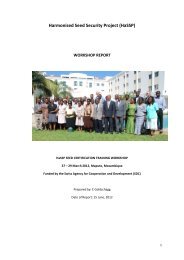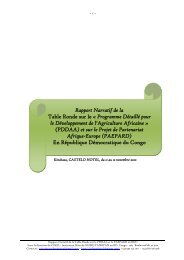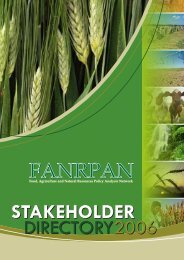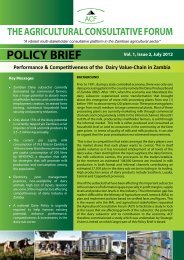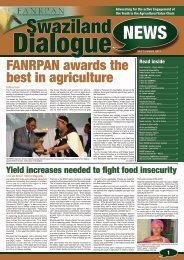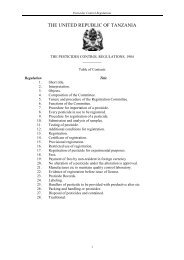CBOs’ effectiveness depends on their leaders’ initiative and capacity to establish linkagesand networks well beyond the frontier of the community. These linkages and networks enablecommunity organizations to moderate the adverse effects of market failures and insufficientgovernment outreach on the livelihoods of their members.Leaders of CBOs, however, cannot fully exploit their potential without an enablinginstitutional environment, which is most often not in place. CDD envisages changes in theinstitutional system in and around the communities that make it possible <strong>for</strong> the CBOs toplay a role in each of the five components of service provision: regulation, planning,production, delivery and financing.Sustainable income and non-income poverty reduction <strong>for</strong> <strong>rural</strong> people are closely linkedwith the institutional <strong>development</strong> of their own organizations.The word “institutions,” as used in this document, refers to theset of working rules in a society which determine “who isBox 2Definition of “community”eligible to make <strong>decision</strong>s in some arenas, what actions areallowed or constrained, what procedures must be followed, and The locus where all memberswhat costs and payoffs are allowed to individuals as a result ofof a group of people, havingsome <strong>for</strong>m of collective claimtheir action”. 4 The working rules may or may not coincide withover a territory andthe <strong>for</strong>mal rules embodied in legislation, administrativerecognizing some <strong>for</strong>m ofregulations or court rulings.collective governance, can begiven the opportunity toDeveloping community level <strong>rural</strong> infrastructureinfluence <strong>decision</strong>s in mattersAn important objective of CDD is to respond to demands <strong>for</strong> of public choice that affectsocial and production infrastructure that the communities cantheir livelihood.operate and maintain with their own resources. The statement That is, the locus whereparticipatory democracy is aof this objective is intentionally different from one whichconcrete possibility.might say, “the objective is to build social and productioninfrastructure <strong>for</strong> the <strong>rural</strong> community” in that the demand<strong>driven</strong>and sustainability aspects (e.g. autonomous <strong>decision</strong>s,willingness to raise resources and technical capacity <strong>for</strong>Box 3organization and management) are emphasized.The system of incentivesFostering the local economy at thecommunity level<strong>IFAD</strong> projects are concerned with directly improving thelivelihoods of poor households living in <strong>rural</strong> communities. Thechances of achieving this objective are enhanced when projectinterventions have a strong impact on the local economy at thecommunity level.The extent to which <strong>IFAD</strong> CDD projects are successful inachieving strong impact depends very much on whether thesystem of incentives (see box 3) encourages communitymembers to make investment <strong>decision</strong>s aimed at increasingproduction, productivity, the long-term conservation of naturalresources and the overall well-being of the community. <strong>IFAD</strong>’sexperience is that <strong>rural</strong> communities respond very rationallywhen consulted or deciding through their own participatoryThe system of incentives isthe set of rewards andpenalties (e.g. financial,social, political oradministrative) that governsthe demand <strong>for</strong> and theproduction and distribution ofgoods and services.Rewards might includeprices, profit, power, status,promotion or winningelections and penalties mayinclude costs, bankruptcy,shame, demotion,marginalization, transfer toposts with no careerprospects or losing elections.4 E. Ostrom, Crafting Institutions in Self Government Irrigation Systems, 1992. In the common language the word “institution” hastwo meanings: one refers to “the rules” and the other is synonymous with the word “organization”. Organizations are groups ofindividuals who come together <strong>for</strong> a common purpose and establish rules which must be respected by the members of the group.Some authors define institutions as those organizations which establish rules that ought to be respected by everybody, not onlyby the members of the organization. Thus, governments and the Central Bank are institutions, while a cooperative and a privatecompany are organizations.11
mechanisms on a list of priority needs and selected investments <strong>for</strong> the welfare of the entirecommunity. They generally place basic social needs at the top of the list, followed by incomegeneratingactivities (e.g. production and marketing).When this kind of behaviour is not witnessed, it is the likely result of the existing system ofincentives. This system is in turn the outcome of market and public policy failures which mustbe corrected in order to change the factors that influence communities’ rational prioritysetting. Such corrections are necessary <strong>for</strong> achieving strong impact on the local economy at thecommunity level.Diversifying the sources of support <strong>for</strong> <strong>rural</strong> communities<strong>IFAD</strong> projects finance activities that mobilize public resources in support of <strong>rural</strong>communities. However, CDD projects are also concerned with• supporting governments to re-focus their activities on the public administration’scomparative advantage;• mobilizing the private sector to provide the services which are outside the sphere ofpublic administration;• broadening beyond the public sector the sources of support that poor <strong>rural</strong> communitiesshould be capable of mobilizing to help themselves.<strong>IFAD</strong>’s policy of involving the private sector, often non-governmental organizations (NGOs),as providers of specialized services to communities is relevant in this respect. This policy hasbroader objectives than seeking agents often believed to be more efficient, more effectiveand more specialized than government agencies. Properly selected and adequatelymonitored NGOs• are capable of establishing strong links with communities by entering in mutuallysupportive partnerships and collaboration with CBOs;• activate themselves to mobilize incremental non-government resources <strong>for</strong> their ownactivities on behalf of the communities;• help build a culture within communities through which it is accepted that governmentscannot exclusively resolve all community problems;• facilitate the mobilization of the communities’ own resources to deal with the privatecommercial sector, allowing communities to pursue more cost-effective service delivery.Over the years, <strong>IFAD</strong> also has made special ef<strong>for</strong>t to help interested governments developnational Civil Society Organizations (CSOs) of public utility, which have been supported inseveral countries to service projects aimed at a high degreeof CDD content. 5 In Western Africa, <strong>for</strong> example, severalBox 4models have been developed in Cape Verde, Mali andWhat does “empowerment”Mauritania. In Cape Verde and Mauritania, governments haveof poor people mean?introduced legislation to rationalize public support <strong>for</strong> this“The expansion of freedomtype of approach.of choice and action, ofassets and capabilities toparticipate in, negotiate with, The definition of empowermentinfluence, control and holdA key concept underlying CDD is the idea of empowerment, anaccountable institutions thatexpression widely used in <strong>development</strong> literature, but not oftenaffect their lives.”defined. The definition used in this document follows that of theSource: World Bank EmpowermentSourcebook 2002 6World Bank’s “Empowerment Sourcebook” and refers directly topeople who are of interest to <strong>IFAD</strong>.5 For a more detailed discussion of CSOs, see Chapter V.6 World Bank. 2002. Empowerment and Poverty Reduction: A Sourcebook-PREM. D. Naryan ed. World Bank.12


